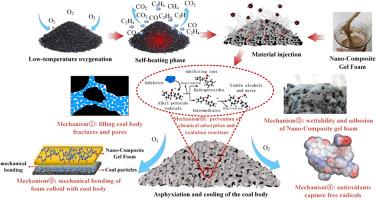防采空区残煤自燃纳米复合凝胶泡沫的制备及性能研究
IF 9.4
1区 工程技术
Q1 ENERGY & FUELS
引用次数: 0
摘要
现有的防止煤自燃技术,如注浆、惰性气体、抑制剂、凝胶、泡沫等,存在污染大、流动性差、高温破坏等显著缺陷。为了探索一种环保、高效、高稳定性的抑制煤自燃的复合凝胶泡沫,将SiO2和叔丁基对苯二酚掺入凝胶泡沫中。利用扫描电镜对纳米复合凝胶泡沫的覆盖能力进行了评价。考察了凝胶的物理性质,即粘度、流动性和热稳定性。通过原位红外光谱模拟,分析了原煤和处理后煤样品中活性官能团的变化。此外,在自制的实验平台上,验证了纳米复合凝胶泡沫防止煤自燃的有效性。结果表明,纳米复合凝胶泡沫使活性官能团变得惰性,有效地抑制了CO和C2H4等气体的产生,同时也覆盖了残余煤的表面,从而阻止了与氧气的直接接触。研究结果为进一步开发防治采空区自燃新技术提供了依据。本文章由计算机程序翻译,如有差异,请以英文原文为准。

Preparation and properties of nano-composite gel foam for preventing spontaneous combustion of residual coal in mined-out areas
Existing technologies for the prevention of spontaneous combustion of coal, such as grouting, inert gases, inhibitors, gels, and foams, have significant drawbacks, including high pollution, poor fluidity, and high-temperature failure. To explore an environmentally friendly, efficient, and highly stable composite gel foam for inhibiting coal self-ignition, SiO2 and tert-butylhydroquinone were incorporated into the gel foam. The coverage ability of the nano-composite gel foam was assessed using scanning electron microscopy. Physical properties of the gel, namely viscosity, fluidity, and thermal stability, were investigated. Through an in situ infrared spectroscopy simulation, we analysed the changes in the active functional groups between the raw coal and treated coal samples. Additionally, the effectiveness of the nano-composite gel foam in preventing coal self-ignition was verified using a custom-built experimental platform. The results demonstrated that the nano-composite gel foam rendered the active functional groups inert and effectively suppressed the generation of gases, such as CO and C2H4, while also covering the surface of the residual coal, thereby blocking direct contact with oxygen. The results of this study provide the basis for further development of new technologies to prevent spontaneous combustion in goaf areas.
求助全文
通过发布文献求助,成功后即可免费获取论文全文。
去求助
来源期刊

Energy
工程技术-能源与燃料
CiteScore
15.30
自引率
14.40%
发文量
0
审稿时长
14.2 weeks
期刊介绍:
Energy is a multidisciplinary, international journal that publishes research and analysis in the field of energy engineering. Our aim is to become a leading peer-reviewed platform and a trusted source of information for energy-related topics.
The journal covers a range of areas including mechanical engineering, thermal sciences, and energy analysis. We are particularly interested in research on energy modelling, prediction, integrated energy systems, planning, and management.
Additionally, we welcome papers on energy conservation, efficiency, biomass and bioenergy, renewable energy, electricity supply and demand, energy storage, buildings, and economic and policy issues. These topics should align with our broader multidisciplinary focus.
 求助内容:
求助内容: 应助结果提醒方式:
应助结果提醒方式:


